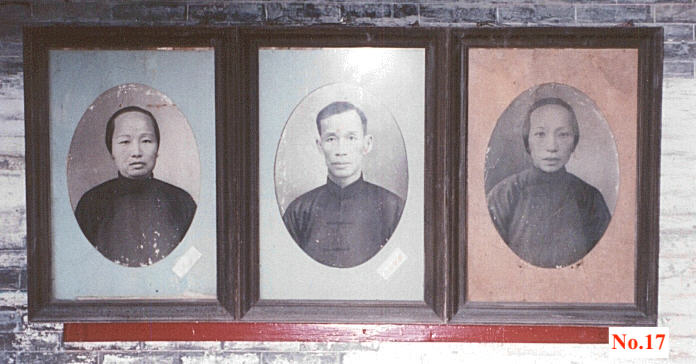
This portrait of Lee Man Duk and his two wives is to be found on the wall of a house in a village of Zhongshan county, south China. The portraits are in a typical memorial style set up by the family to honour departed family members. In this case the three people portrayed are also fairly typical of those from this and neighbouring villages who maintained close links with Australia throughout their lives. Though in the case of the two women portrayed this did not involve any time spent in Australia.
It is often remarked that the 19thcentury presence of people from China was overwhelmingly male and it is certainly true that comparatively few Chinese women found their way to Australia before the second half of the 20thcentury. But this is not to say there were not large numbers of women whose lives were strongly linked to Australia over many generations. In fact while most Chinese people in Australia during the gold rush and in the years afterwards were men they were not single men, at least not after the first few years working in Australia. This was because having once made some money in Australia through one or a number of a wide range of occupations (see No. 3 & No.4) it was common for these ‘bachelors’ to return to their home villages to marry. And having done so once, to return, perhaps a number of times, to ensure the birth of children and in some cases to marry a second time. [See No. 1]
This was a pattern of behaviour that was common throughout the Pacific and South-East Asia and one that constituted success, including a final retirement trip, in the eyes of the village based family. Those that remained in places like Australia, to marry there and settle were for many generations a minority. But of course overtime things change and not only did the tendency to settle and bring women change so too did the idea that monogamy was a more appropriate form of marriage despite its long traditional existence in China. [See No. 11]
However for Man Duk Lee and his family the success of his work as a market gardener and in later life as the owner of a fruit shop in Sydney’s Kogarah allowed him to marry two wives (technically one wife and one concubine) and according to his son who also came to Sydney, they lived together quite amicably. Two women whose lives were strongly linked, as were so many in similar circumstances through their husbands, sons and fathers with Australia.
See also
For more on Chinese women in Australia:
‘Rewriting the history of Chinese families in nineteenth-century Australia’, Australian Historical Studies, vol. 42, no. 1, March 2011, pp. 62–77 by Kate Bagnall
For more on Chinese women (Australian linked) in China:
Williams, M., 2021. Holding Up Half the Family, Journal of Chinese Overseas 17.1, pp.179-195. https://doi.org/10.1163/17932548-12341438
For more on changes attitudes to polygamy see:
The Poison of Polygamy (University of Sydney Press, 2019) by Wong Shee Ping

